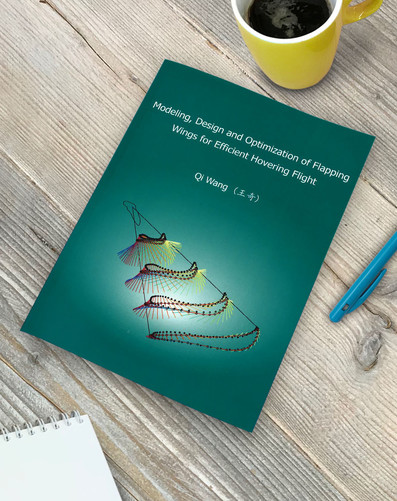
Inspired by insect flights, flapping wing micro air vehicles (FWMAVs) keep attracting attention from the scientific community. One of the design objectives is to reproduce the high power efficiency of insect flight. However, there is no clear answer yet to the question of how to design flapping wings and their kinematics for power-efficient hovering flight. In this thesis, we aim to answer this research question from the perspectives of wing modeling, design and optimization.Quasi-steady aerodynamic models play an important role in evaluating aerodynamic performance and designing and optimizing flapping wings.
In Chapter 2, we present a predictive quasi-steady model by including four aerodynamic loading terms. The loads result from the wing's translation, rotation, their coupling as well as the added-mass effect. The necessity of including all four of these terms in a quasi-steady model to predict both the aerodynamic force and torque is demonstrated. Validations indicate a good accuracy of predicting the center of pressure, the aerodynamic loads and the passive pitching motion for various Reynolds numbers. Moreover, compared to the existing quasi-steady models, the proposed model does not rely on any empirical parameters and, thus, is more predictive, which enables application to the shape and kinematics optimization of flapping wings. For flapping wings with passive pitching motion, a shift in the pitching axis location alters the aerodynamic loads, which in turn change the passive pitching motion and the flight efficiency.
Therefore, in Chapter 3, we investigate the optimal pitching axis location for flapping wings to maximize the power efficiency during hovering flight. Optimization results show that the optimal pitching axis is located between the leading edge and the mid-chord line, which shows a close resemblance to insect wings. An optimal pitching axis can save up to 33% of power during hovering flight when compared to optimized traditional wings used by most of the flapping wing micro air vehicles (FWMAVs). Traditional wings typically use the straight leading edge as the pitching axis. In addition, the optimized pitching axis enables the drive system to recycle more energy during the deceleration phases as compared to their counterparts. This observation underlines the particular importance of the wing pitching axis location for energy-efficient FWMAVs when using kinetic energy recovery drive systems. The presence of wing twist can alter the aerodynamic performance and power efficiency of flapping wings by changing the angle of attack.
In order to study the optimal twist of flapping wings for hovering flight, we propose a computationally efficient fluid-structure interaction (FSI) model in Chapter 4. The model uses an analytical twist model and the quasi-steady aerodynamic model introduced in Chapter 2 for the structural and aerodynamic analysis, respectively. Based on the FSI model, we optimize the twist of a rectangular wing by minimizing the power consumption during hovering flight. The power efficiency of the optimized twistable wings is compared with corresponding optimized rigid wings. It is shown that the optimized twistable wings can not dramatically outperform the optimized rigid wings in terms of power efficiency, unless the pitching amplitude at the wing root is limited. When this amplitude decreases, the optimized twistable wings can always maintain high power efficiency by introducing certain twist while the optimized rigid wings need more power for hovering.
Considering the high impact of the root stiffness on flapping kinematics and power consumption, we present an active hinge design which uses electrostatic force to change the hinge stiffness in Chapter 5. The hinge is realized by stacking three conducting spring steel layers which are separated by dielectric Mylar films. The theoretical model shows that the stacked layers can switch from slipping with respect to each other to sticking together when the resultant electrostatic force between layers, which can be controlled by the applied voltage, is above a threshold value. The switch from slipping to sticking will result in a dramatic increase of the hinge stiffness (about 9x). Therefore, a short duration of the sticking can still lead to a considerable change in the passive pitching motion. Experimental results successfully show the decrease of the pitching amplitude with the increase of the applied voltage.
Flight control based on the electrostatic force can be very power-efficient since there is ideally no power consumption due to the control operations. In Chapter 6, we retrospect and discuss the most important aspects related to the modeling, design and optimization of flapping wings for efficient hovering flight. In Chapter 7, the overall conclusions are drawn and recommendations for further study are provided.
Download Thesis